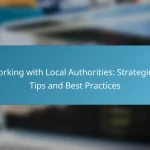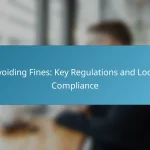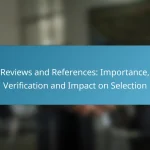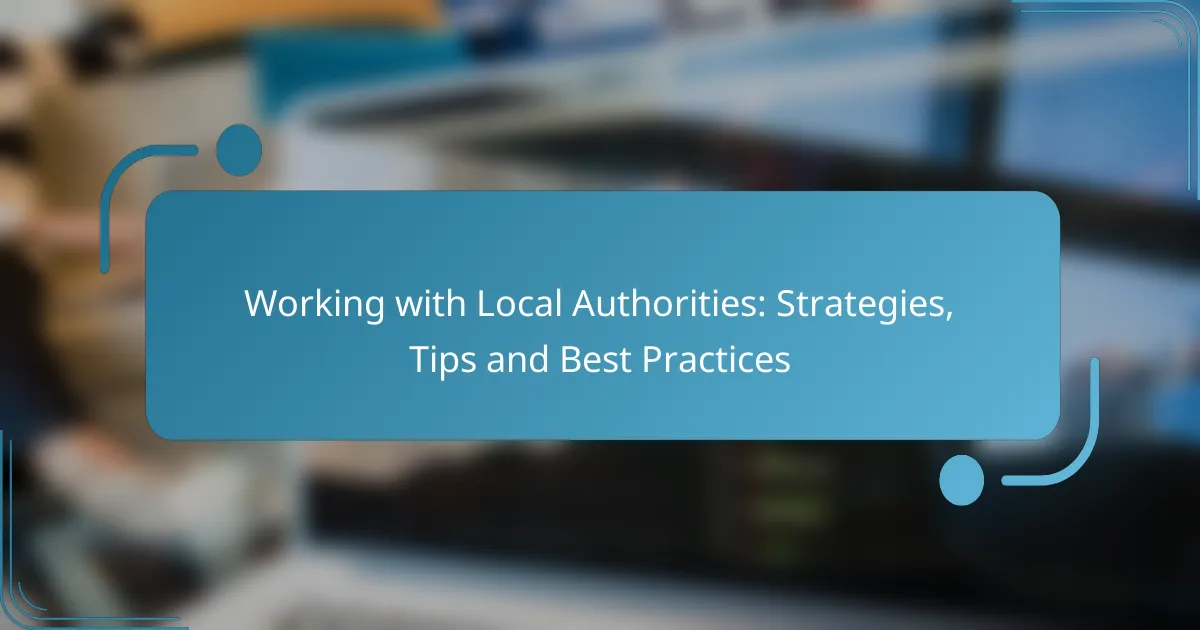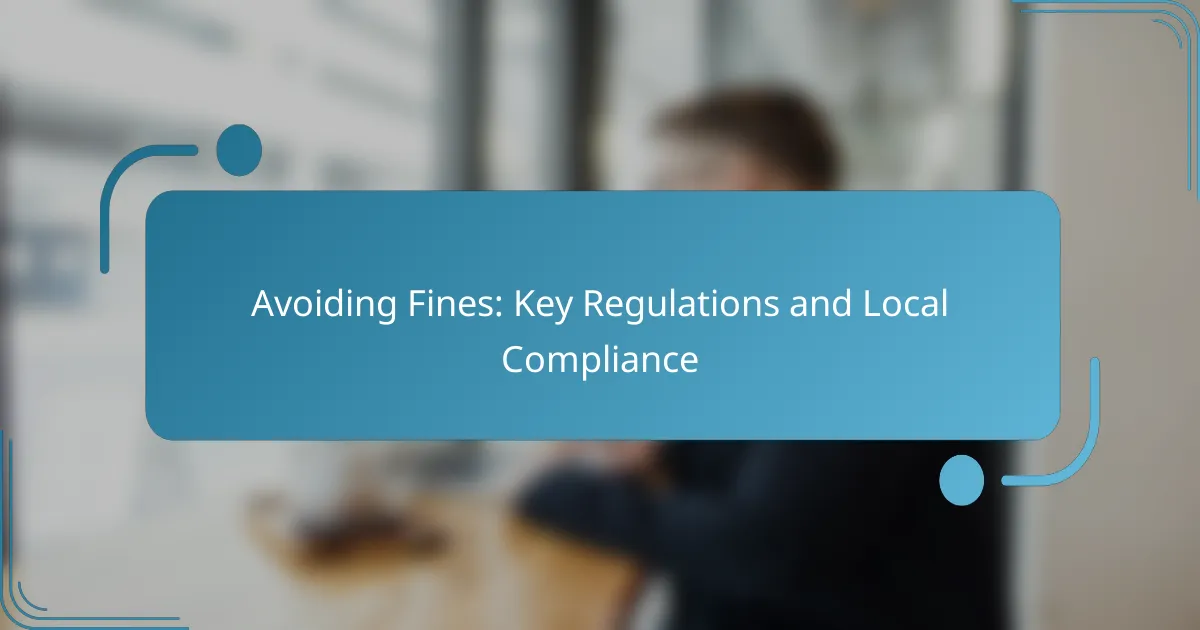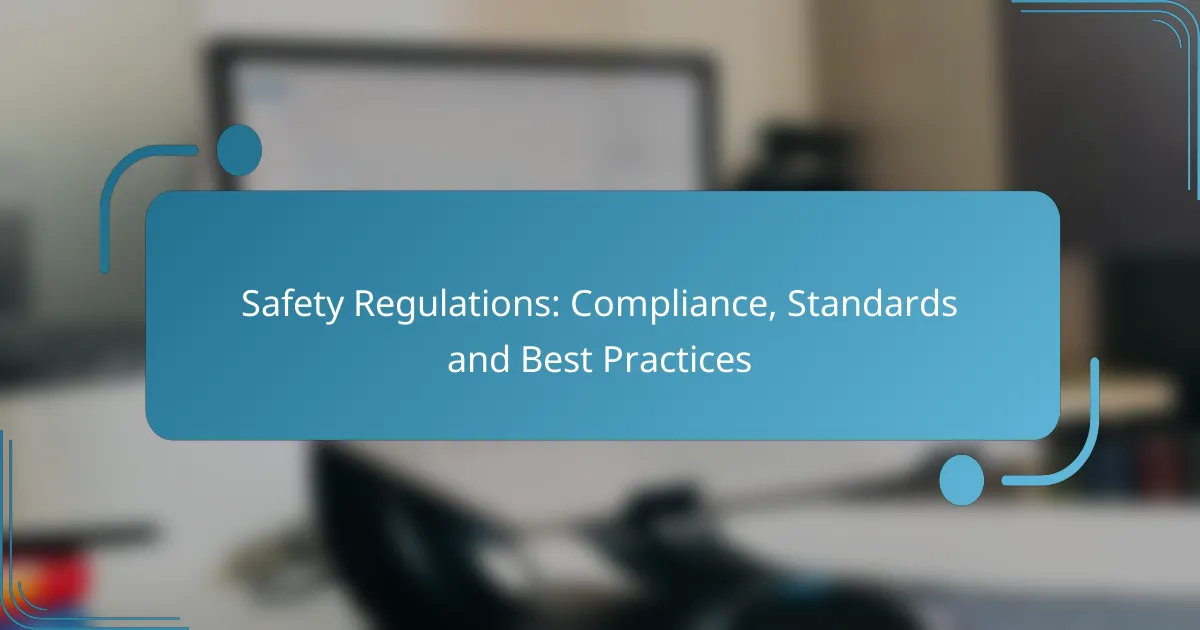Working effectively with local authorities is crucial for the success of community-focused initiatives. By prioritizing clear communication, building trust, and engaging stakeholders, organizations can navigate regulations and foster productive partnerships. Implementing strategies that align project goals with community needs enhances collaboration and ensures that local requirements are met.
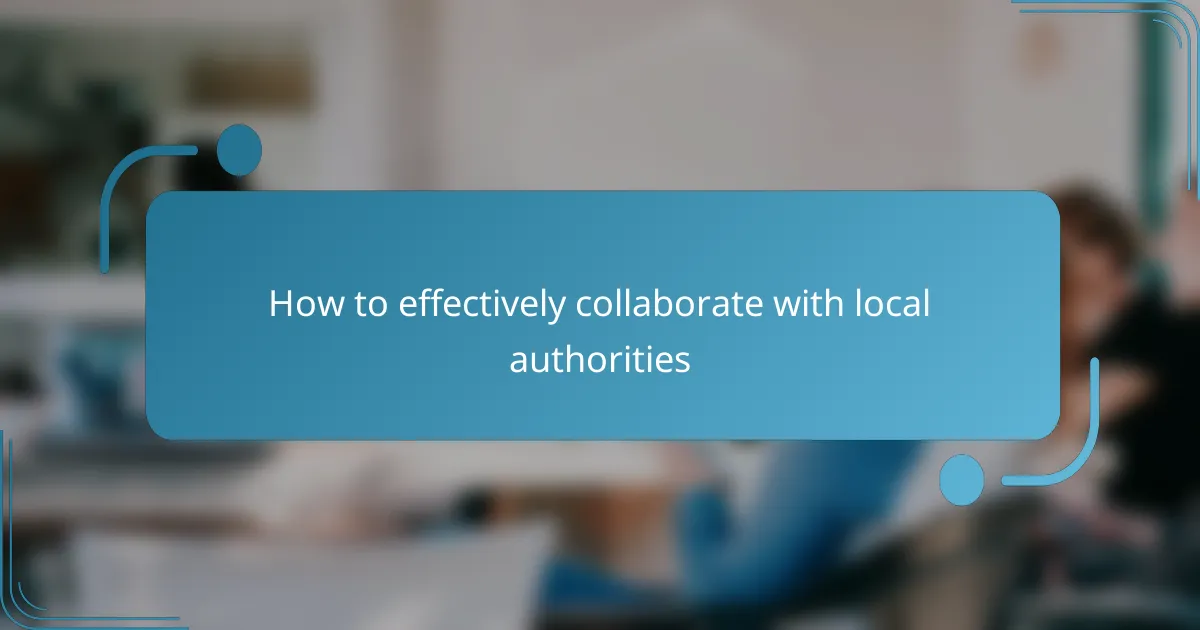
How to effectively collaborate with local authorities
Effective collaboration with local authorities involves establishing strong communication, building trust, and engaging stakeholders. By following best practices, organizations can navigate local regulations and foster productive relationships.
Establish clear communication channels
Clear communication is essential for successful collaboration with local authorities. Establish dedicated points of contact and use multiple channels such as emails, phone calls, and in-person meetings to ensure messages are conveyed effectively.
Consider creating a shared online platform for updates and document sharing. This can streamline communication and keep all parties informed about project developments and regulatory changes.
Build trust through transparency
Transparency is crucial in building trust with local authorities. Share relevant information openly, including project goals, timelines, and potential challenges. This openness can help mitigate misunderstandings and foster a cooperative atmosphere.
Regularly report on progress and be upfront about setbacks. Demonstrating accountability can strengthen relationships and encourage local authorities to support your initiatives.
Engage in regular meetings
Regular meetings with local authorities help maintain momentum and address issues promptly. Schedule these meetings consistently, whether weekly or monthly, to discuss updates, gather feedback, and align on objectives.
Prepare agendas in advance to ensure meetings are focused and productive. Document outcomes and action items to keep all parties accountable and informed.
Utilize local government platforms
Local government platforms often provide valuable resources for collaboration. Familiarize yourself with these tools, such as online portals for permits, public notices, and community engagement initiatives.
Using these platforms can enhance visibility and streamline processes, making it easier to comply with local regulations and engage with the community.
Involve community stakeholders
Involving community stakeholders is vital for successful collaboration with local authorities. Identify key groups, such as neighborhood associations, business organizations, and advocacy groups, and engage them early in the process.
Facilitate discussions to gather input and address concerns. This inclusive approach not only builds support but also helps ensure that projects align with community needs and expectations.
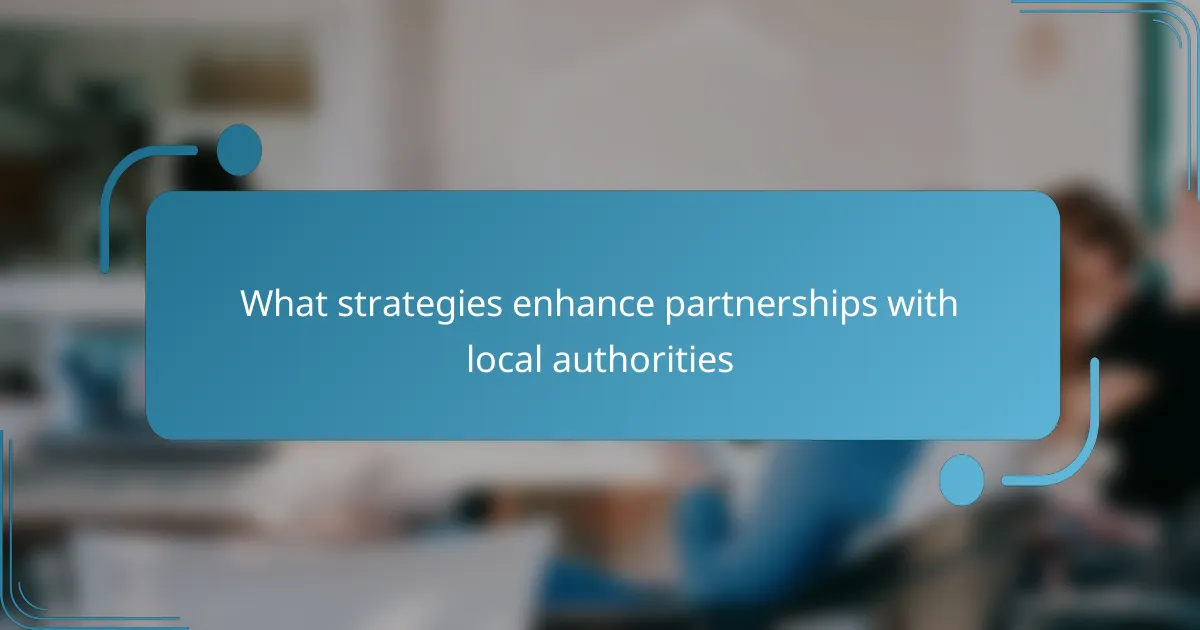
What strategies enhance partnerships with local authorities
Effective strategies for enhancing partnerships with local authorities include leveraging local knowledge, aligning goals with community needs, and implementing joint initiatives. These approaches foster collaboration and ensure that projects meet the specific requirements of the community.
Leverage local knowledge and expertise
Utilizing local knowledge and expertise is crucial for building strong relationships with local authorities. Engaging community leaders and stakeholders can provide valuable insights into the unique challenges and opportunities within the area.
Consider organizing workshops or forums where local experts can share their experiences and suggestions. This not only builds trust but also helps in tailoring initiatives that are more likely to succeed.
Align goals with community needs
Aligning your goals with the needs of the community ensures that your partnership with local authorities is relevant and impactful. Conducting surveys or focus groups can help identify the priorities of the community, allowing for a more targeted approach.
Regularly revisiting these goals and adapting them based on community feedback is essential. This responsiveness can significantly enhance the effectiveness of your collaboration and foster goodwill among local stakeholders.
Implement joint initiatives
Joint initiatives between your organization and local authorities can lead to more effective outcomes and resource sharing. These initiatives could range from community development projects to public health campaigns, depending on local needs.
Establish clear roles and responsibilities for each partner to avoid misunderstandings. Regular progress meetings can help keep all parties aligned and allow for adjustments as necessary, ensuring that the initiatives remain relevant and effective.
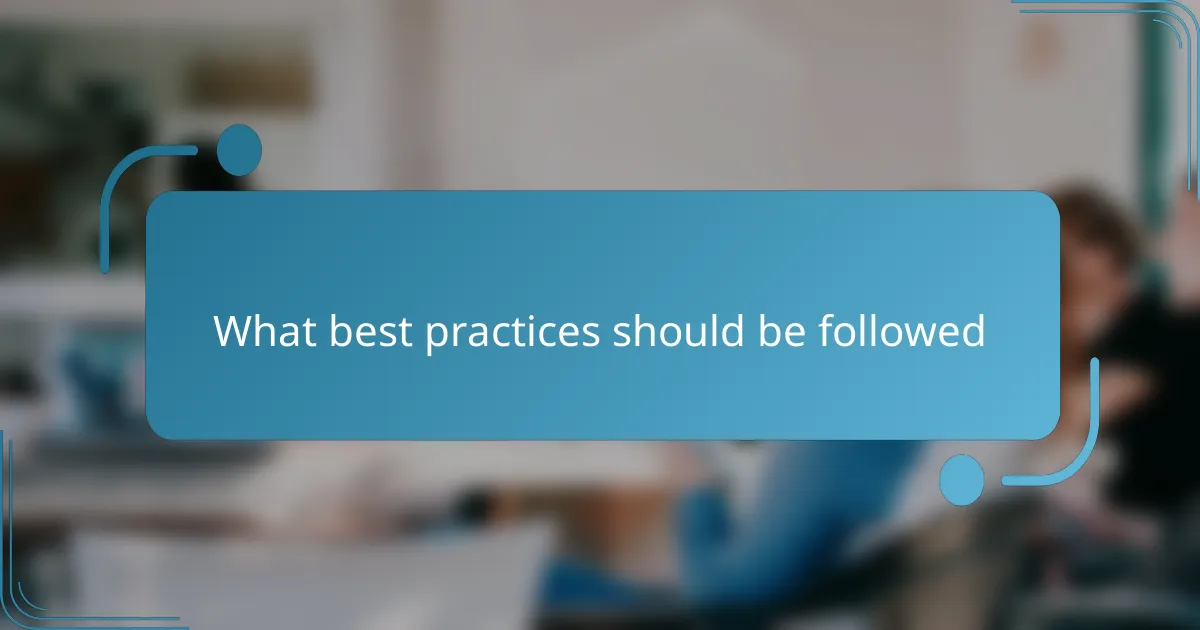
What best practices should be followed
To effectively work with local authorities, it is essential to follow best practices that promote clear communication, accountability, and collaboration. These practices help ensure that projects align with community needs and regulatory requirements.
Document agreements and responsibilities
Clearly documenting agreements and responsibilities is crucial for accountability in projects involving local authorities. This includes outlining the roles of all parties, deadlines, and specific deliverables. A well-structured memorandum of understanding (MOU) can serve as a formal record of these agreements.
Regularly revisiting and updating these documents can help avoid misunderstandings and ensure that all stakeholders remain aligned throughout the project lifecycle. Consider using project management tools to track changes and maintain transparency.
Maintain flexibility and adaptability
Flexibility and adaptability are key when working with local authorities, as regulations and community needs can change. Being open to adjustments in project scope or timelines can facilitate smoother interactions and foster goodwill. For instance, if a local regulation shifts, being willing to modify your approach can prevent delays.
Establishing regular check-ins with local authorities can help identify potential issues early and allow for timely adjustments. This proactive approach can save time and resources in the long run.
Foster a culture of collaboration
Creating a culture of collaboration is vital for successful partnerships with local authorities. Encourage open communication and invite input from all stakeholders to ensure diverse perspectives are considered. This can lead to more innovative solutions that better serve the community.
Organizing workshops or community forums can facilitate collaboration and strengthen relationships. Additionally, recognizing and celebrating joint successes can reinforce a collaborative spirit and motivate continued partnership efforts.

How to navigate regulatory requirements
Navigating regulatory requirements involves understanding the specific rules and guidelines set by local authorities that govern your operations. Compliance is crucial to avoid penalties and ensure smooth interactions with these entities.
Understand local regulations
Understanding local regulations is essential for any business or organization. These regulations can vary significantly by region and may include zoning laws, environmental standards, and health codes. Familiarize yourself with the specific requirements that apply to your industry and location.
Start by reviewing official government websites or local authority resources to gather information on the applicable regulations. Consider attending workshops or seminars that focus on regulatory compliance to deepen your understanding.
Engage legal counsel for compliance
Engaging legal counsel is a smart strategy to ensure compliance with local regulations. A qualified attorney can provide insights into complex legal language and help interpret how regulations apply to your specific situation. This can save you time and prevent costly mistakes.
When selecting legal counsel, look for professionals with experience in your industry and familiarity with local laws. They can assist in drafting necessary documents, navigating permits, and representing you in discussions with local authorities.
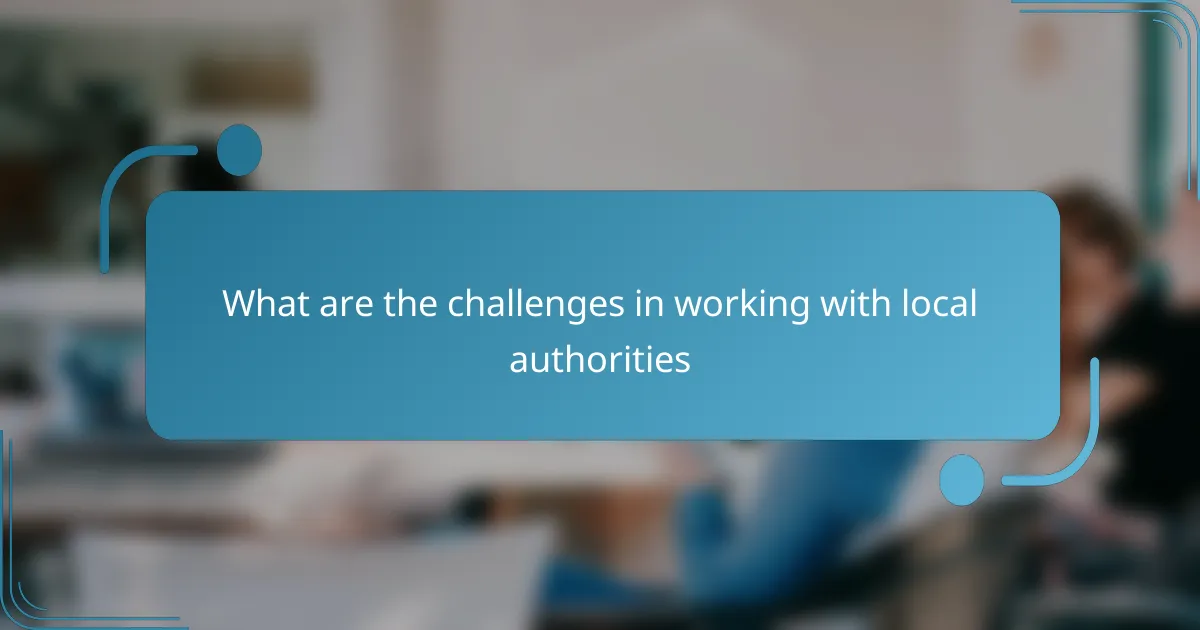
What are the challenges in working with local authorities
Working with local authorities often involves navigating complex regulations, varying priorities, and bureaucratic processes. These challenges can hinder project timelines and require strategic approaches to ensure successful collaboration.
Address bureaucratic hurdles
Bureaucratic hurdles can slow down project approvals and implementation. Local authorities typically have established procedures that must be followed, which can include multiple layers of review and approval. Understanding these processes beforehand can help in planning and avoiding delays.
To effectively address these hurdles, familiarize yourself with the specific regulations and requirements of the local authority you are working with. Create a checklist of necessary documents and approvals to streamline the process. Engaging with a local consultant or legal expert can also provide valuable insights into navigating these complexities.
Manage differing priorities
Local authorities often have priorities that may not align with your project goals. For instance, while you may focus on efficiency and cost-effectiveness, local authorities might prioritize community impact and regulatory compliance. Recognizing these differing priorities is essential for successful collaboration.
To manage these differences, initiate open dialogues with local officials to understand their objectives. Establish common ground by aligning your project goals with community benefits. Regular updates and transparent communication can help maintain trust and ensure that all parties remain focused on shared outcomes.
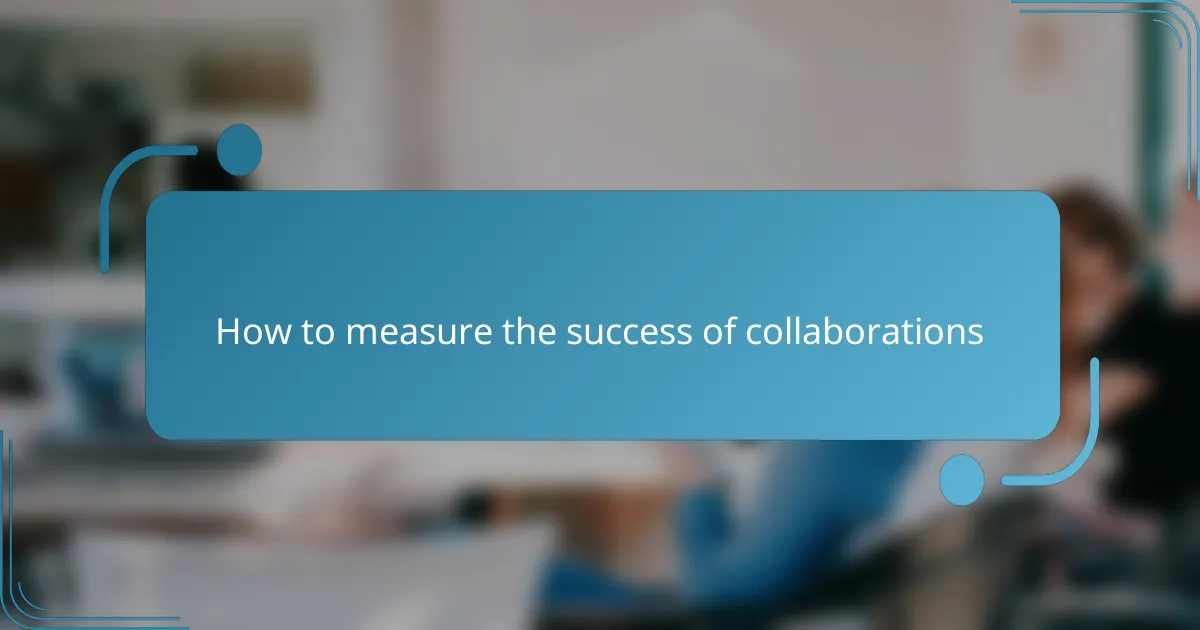
How to measure the success of collaborations
Measuring the success of collaborations with local authorities involves evaluating specific outcomes against established goals. Key metrics can include stakeholder satisfaction, project completion rates, and the impact on community needs.
Set clear performance indicators
Establishing clear performance indicators is essential for assessing collaboration success. These indicators should be specific, measurable, achievable, relevant, and time-bound (SMART). For example, you might track the number of community events held or the percentage increase in local service utilization.
Consider using both qualitative and quantitative metrics. While numerical data can provide clear insights, qualitative feedback from participants can reveal deeper issues or successes that numbers alone may miss.
Gather feedback from stakeholders
Regularly gathering feedback from stakeholders is crucial for understanding the effectiveness of collaborations. This can be achieved through surveys, focus groups, or informal discussions. Aim to include a diverse range of voices, including community members, local officials, and partner organizations.
Feedback should be analyzed systematically to identify trends and areas for improvement. For instance, if multiple stakeholders express concerns about communication, addressing this issue can enhance future collaboration efforts.
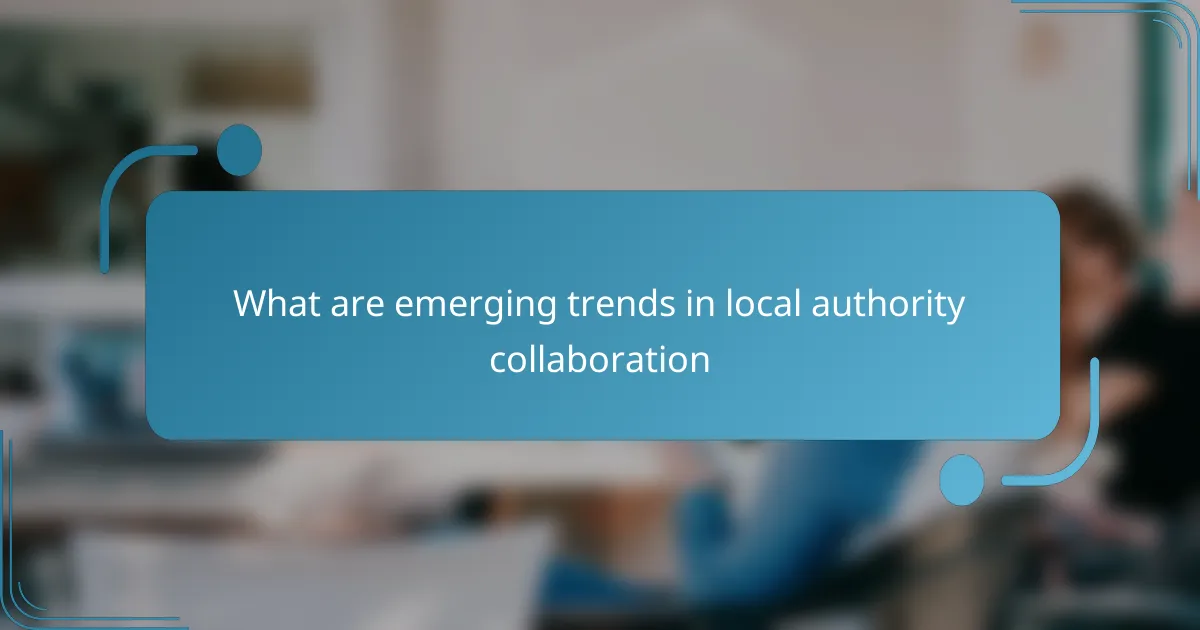
What are emerging trends in local authority collaboration
Emerging trends in local authority collaboration focus on enhanced partnerships, data sharing, and community engagement. These trends aim to improve service delivery and foster innovation in addressing local issues.
Increased use of technology
Local authorities are increasingly adopting technology to streamline collaboration. Tools such as cloud-based platforms and mobile applications facilitate real-time communication and data sharing among stakeholders. This shift not only enhances efficiency but also allows for better tracking of projects and initiatives.
For example, many local governments are using Geographic Information Systems (GIS) to visualize data and improve decision-making processes. This technology helps in planning and managing resources more effectively.
Focus on community engagement
Engaging the community is becoming a priority for local authorities. By involving residents in decision-making processes, authorities can better understand community needs and preferences. This approach fosters trust and encourages active participation in local governance.
Methods such as public forums, surveys, and social media outreach are being used to gather feedback and ideas from the community. Authorities that prioritize engagement often see higher satisfaction rates among residents.
Collaborative funding models
Emerging funding models emphasize collaboration between local authorities and private sectors or non-profits. These partnerships can leverage resources and expertise to tackle local challenges more effectively. By pooling funds, stakeholders can undertake larger projects that may not be feasible individually.
For instance, joint ventures in urban development or environmental initiatives can attract investment and share risks, leading to more sustainable outcomes for communities.

